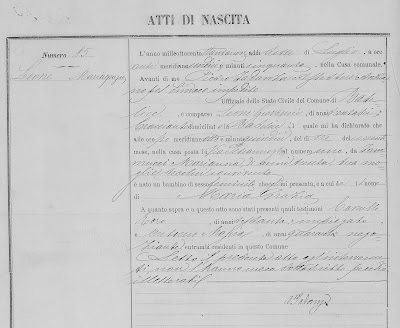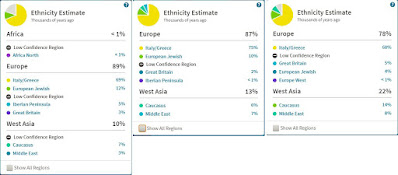 |
1809 birth record for foundling Maria Giuseppa.
I had the wrong image here before! |
When I began researching Italian birth records from the 1800s, I noticed something curious.
In one small town, a few babies were born each year to:
- padre incerto (father uncertain)
- madre ignoto (mother unknown)
- genitori ignoti (parents unknown)
These babies were often listed separately from the other births and labelled projetti. I asked my friend to explain this to me. He is an expert in Italian genealogy who comes from one of my ancestral towns.
He told me the projetti were babies abandoned at birth. The father's identity was unknown, and the mother's identity was known only to the midwife.
What's an Unwed 1800s Mother To Do?
Try to imagine a young woman in Roman Catholic Italy in the 1800s who finds herself pregnant and unmarried. Maybe the man refuses to marry her. Maybe he refuses to acknowledge that he is the father of the baby.
What does this young woman do to avoid bringing dishonor to herself and her family?
 |
| Angelamaria Biferno is named after a river in the area. |
First she would have to hide her pregnancy, possibly leaving town for made-up reasons. Then she could deliver her baby with the help of a midwife who would keep her identity a secret. The midwife (levatrice in Italian) would report the birth to the mayor without naming the baby's mother or father.
If you are the descendant of an abandoned infant, you may find the birth record in the town where the baby was raised. The baby might have been raised in a foundling home, a foster home, or a monastery.
This was a system that saved the pregnant woman from shame and gave the baby a chance at life.
A Sign to Identify the Baby
There was a way for a mother to reclaim her abandoned infant. At the time of birth, she could leave with the baby some item that only she could identify. It might be something as simple as a piece of cloth or a blanket.
She could later claim the baby by describing the item and the date of birth. This rarely happened.
A Unique Name for the Baby
The midwife or the mayor himself named the abandoned babies. They used a last name (cognome in Italian) that was different than the names in that town. Sometimes it was a geographical name. A handful of names commonly used for projetti include:
- Innocenti, meaning innocent one
- Projetti, the same as the registry of abandoned baby birth records
- Esposito, meaning abandoned
- Incogniti, meaning unknown
This can lead to confusion for family tree researchers because the baby kept this name for life. A man named Esposito, abandoned at birth, would pass the name Esposito on to his children, and his sons would pass it on to their children.
Don't assume that your Esposito ancestor was an abandoned baby.
In my grandfather's hometown of Baselice, Italy, they preferred to name abandoned babies after rivers and towns. They did not give them a name that marked them for life as abandoned.
Or Maybe It's Not an Illegitimate Birth
Now let me throw a monkey wrench into your family tree research. Sometimes the abandoned baby was not born out of wedlock.
It is known that in Milan and Florence ... the majority of abandoned children were legitimate.
We can guess: poverty, deformity, severe illness. Imagine how heartbreaking that must have been for the woman giving birth.
Two Examples
The images in this article include two examples of projetti from the rural town of Baselice. I found a handful of projetti recorded each year from 1809 through 1860.
The first image does not give the foundling a last name. Since the document explains how my fifth great grandfather, Nicola Pisciotti, found the baby, I thought he and his wife had raised her.
The document says my ancestor, age 60, found the baby girl outside his door. She had no identifying item that the mother could use to reclaim her baby.
The mayor names the baby Maria Giuseppa and turns her over to a nurse. So the baby girl is probably raised in a foundling home or in the monastery along with many other projetti.
The second image is the birth record of Angelamaria Biferno in 1815. Biferno is not a last name found in the town of Baselice, but it is the name of a nearby river. Dorodea Colucci was the midwife who delivered Angelamaria and most of the babies in this town. She goes to the mayor and presents the baby, wrapped in a black rag, but without any other sign from its mother.
Angelamaria Biferno grew up in the same town and married there. Unfortunately she died at age 28 and had no children.
Angelamaria Biferno is a big puzzle for me. Marriage records from 1843 include another Angelamaria Biferno, born about the same time, and in the same town. She was also an abandoned baby. She married a man in Baselice the same year the first Angelamaria Biferno died. They had at least six children together.
The confusing, overlapping case of the two Angelamaria Biferno's needs detailed examination. Let's save that for another day.










